The Story Behind the Photograph
Photographing the Running Collared Lizard
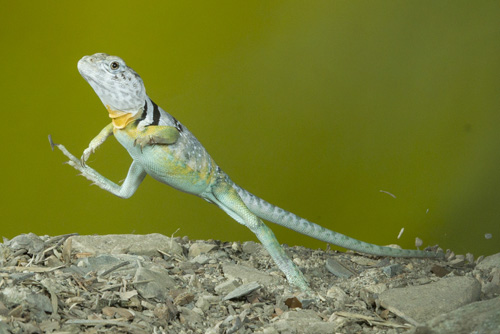
Collared Lizard running, shot with a High Speed Shutter
Just hours ago I continued with a two-week long project that I hadn’t been able to do for over twelve years. Back then, over a decade ago, I photographed a Collared Lizard, one of the larger US running on its hind legs like a little Tyrannosaurus Rex. Most lizards, worldwide, simply scurry away on all four legs when fleeing, but a few, like the Collared Lizard, the Basilisk Lizards, and Frilled Lizards or Dragons, may adopt a bipedal gait when running quickly. When I shot those Collared Lizard images years ago I did so with film, using an EOS 1 RS camera which had a pellicle mirror and, consequently, a very short lag-time of only 1/180th of a second or so.
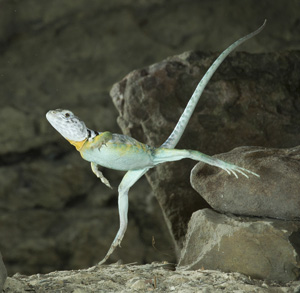
As I’ve addressed previously, camera lag time is the time between when an electrical signal from a tripping device triggers the camera and the time the camera actually fires. The analogy I often use for this is with an automatic door opener, and to imagine yourself running full-blast towards a grocery store equipped with this type of door. These automatic door openers are designed to open in time for a normal walking pace, and not for someone running fast where the door couldn’t open fast enough and the runner would smash into the glass door. With cameras, the lag results in the shutter opening so late behind the trigger that the subject might be out of the frame when the camera actually fires. The EOS camera’s lag time was so short that this didn’t happen, and consequently I captured flying birds, striking rattlesnakes, jumping insects, and running, or leaping, lizards. I’d love to sell these RS cameras, if you are interested!
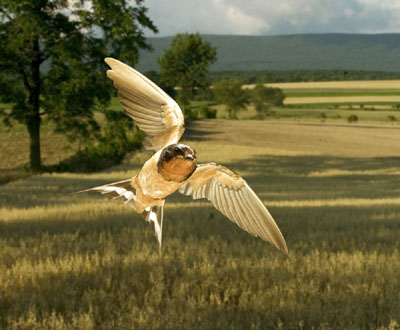 In today’s digital world I didn’t have a camera that had the necessary short lag time, so trying to capture diurnal action, like a flying bird or a running lizard, was more trouble than it was worth. I did a few projects with this limitation, including fast flying Barn Swallows, but for many I just passed, as the attempt wasn’t worth all the trouble.
In today’s digital world I didn’t have a camera that had the necessary short lag time, so trying to capture diurnal action, like a flying bird or a running lizard, was more trouble than it was worth. I did a few projects with this limitation, including fast flying Barn Swallows, but for many I just passed, as the attempt wasn’t worth all the trouble.
When I started using the Cognisys High-Speed External Shutter those shelved projects were once again possible, and I started working on shots I’ve put off for years. The High-Speed External Shutter (HSES) has a 5 millisecond delay time, an almost instantaneous response, but for this to work with a camera the camera must be set on Bulb, so that the shutter is open at the moment of exposure. The HSES mounts to the front of a camera lens and, in that position, acts as the camera’s shutter.
The HSES and the StopShot control fires the shutter, a flash that I use as a ‘master’ to trigger my main ‘slave’ flashes that determine the exposure, and, after the HSES fires, closes the camera shutter and advances to the next frame, and reopens the camera shutter so I’m ready for the next shot. With the minimal lag-time I can catch the lizard as it runs along its path.
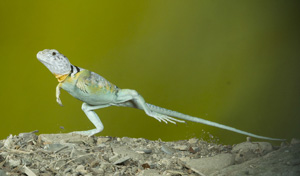
I used two Range IR infrared tripping devices to trigger the HSES system, arranging the Range IRs so that they were stacked above one another, covering the path of the lizard in a vertical plane. In this way, when the lizard crossed the beams it would be doing so at just one point. If I had placed the beams horizontally I’d have the option of setting the StopShot’s configuration so that one beam had to be broken before the other, but for this project that wasn’t necessary. Vertically, I covered a larger area so that if the lizard ran high it might step over one beam but would trip the other positioned above it.
For lighting I used Einstein 640 flashes that I powered down to a very low power ratio, which gave me close to the fastest flash duration possible. For flash shots, flash duration works like a shutter speed, and the faster the flash, produced by selecting a low power ratio, the more action-stopping ability you have. At full power, a flash fires at its slowest duration, which might be relatively fast (in terms of camera shutter speeds), but might be too slow to really stop action.
Since the HSES has a 37mm aperture, vignetting can be an issue, especially at shorter focal lengths and at both wide and very small apertures. I’ve found f11 to f18 to work well with my 70-200mm f4 lens, especially when coupled to a Canon EOS 7D or Mark IV. Since the 7D has a 1.6X crop factor, and the Mark IV a 1.3X crop factor, the corners of the frame are completely or nearly completely cropped out. With the 7D there is virtually no vignetting at these apertures, and only a minor darkening around the edges with a Mark IV. With a full frame sensor camera I’d have to center my subject and keep the image size rather small because of the vignetting, but if you can discipline yourself to do so then a post-production crop would result in the same image as a 7D. And, depending upon the file size of your full frame camera, you might have an image of even greater quality.
 I borrowed the collared lizard from a private collection, as collared lizards live in the southwestern US and I’m in Pennsylvania, and I had two weeks to get my shots, accomplished in the few hours or minutes of ‘down time’ I had during this period while I was teaching our Digital Complete Nature Photo Course. It was fun to show our students the setup and the equipment involved, and then to show them the shots if I had some success.
I borrowed the collared lizard from a private collection, as collared lizards live in the southwestern US and I’m in Pennsylvania, and I had two weeks to get my shots, accomplished in the few hours or minutes of ‘down time’ I had during this period while I was teaching our Digital Complete Nature Photo Course. It was fun to show our students the setup and the equipment involved, and then to show them the shots if I had some success.
The equipment involved was pretty extensive. It included 5 Einstein 640 flash heads, supported by three 12 foot Manfrotto heavy-duty light stands and two Manfrotto Variable Friction Magic Arms; a Really Right Stuff Versa TVC-24L tripod and BH55 ballhead and TA-2-LB leveling base; the Really Right Stuff Mini-Clamp Package for mounting the camera to the External Shutter Support System; two Range IR infrared triggers, one StopShot, and one High Speed External Shutter; and a Canon EOS camera, 70-200mm f4 lens, and a 550 flash that acted as the master to trip the Einstein flashes.
Some lizards run, some do not, and some may run on their hind legs once and then quit. A truly wild lizard might rip across the set but my lizard would usually only run a few times before reverting to a four-legged scurry. Nonetheless, with the HSES I made several great images, fulfilling a wish I’d had since I abandoned film and my EOS 1N RS for the digital world.
I still have a week to go before I have to return the lizard, and I’m still hoping to make the ultimate running lizard shot but as I walked across the small stretch of woods separating my office from my studio I thought about the other subjects I hope to shoot. These projects always take time, and if you have limited time but a lot of energy and you are interested in this type of work, it might be worth having two entire systems. Set-ups, whether they are studio-based or done in the field, generally involve enough work and preparation that it is generally impractical to tear down one set to make another, only to rebuild the original set the following day. Having two complete systems would be especially useful during the spring and summer when insects are abundant and birds especially cooperative for coming to bait sites, and you could accomplish much more than one or two great projects per season. Of course, you could be satisfied with one great series of a given subject, but if you’re like me, and you finally have the opportunity to work something you haven’t had a chance at for years, I’m always after an even better image.
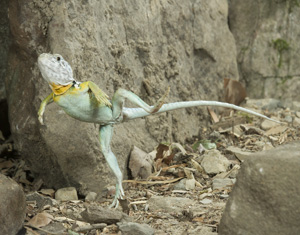
If you are interested in reptile photography, in late June and early July of 2014 we'll be offering another one of our Reptiles of the World Photo Workshop and Shoot where participants will photograph at least 60 different species of herptile. You can check the brochure for links to portfolios taken during these workshops. Also, I may offer an Advanced Digital Nature Photo Course devoted to flash and high speed flash and remote camera tripping devices, like what I'm illustrating on this page, in late July of 2014. Exact dates are not yet determined, but you can contact our office to be placed on our first contact list.
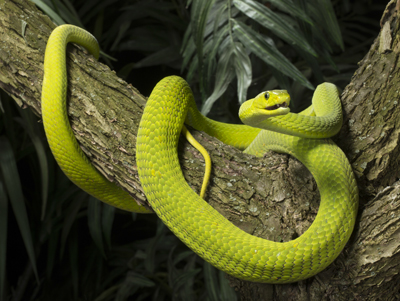
Past Stories Behind the Photograph
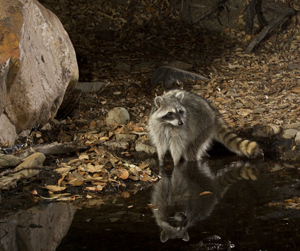
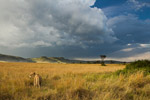

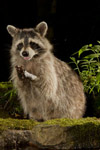
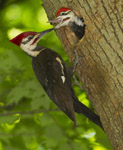


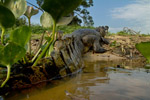
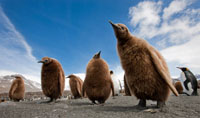
.jpg)

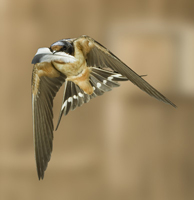
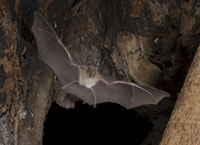

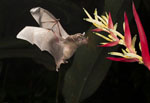
.jpg)
The Jumping American Toad
Bats in Costa Rica
African Bats
The Ocelot
The Waterhole
Bushbaby
Barn Swallow
King Penguin
The Lion and the Landscape
The Bighorn Sheep
The Raccoon
The Pileated Woodpecker
The Striking Rattlesnake
The Pink Salmon
The Spectacled Caimen
Check out our latest web site,
mcdonaldwildlifephotos.com
where we'll be adding portfolios and eventually building up
a searchable data base for photo buyers. We've just started,
and the selection is limited, but it is still worth a visit!
Office Phone: (717) 543-6423
Or FAX us at: (717) 543-5342
The Story Behind the Photograph
Photographing the Running Collared Lizard

Collared Lizard running, shot with a High Speed Shutter
Just hours ago I continued with a two-week long project that I hadn’t been able to do for over twelve years. Back then, over a decade ago, I photographed a Collared Lizard, one of the larger US running on its hind legs like a little Tyrannosaurus Rex. Most lizards, worldwide, simply scurry away on all four legs when fleeing, but a few, like the Collared Lizard, the Basilisk Lizards, and Frilled Lizards or Dragons, may adopt a bipedal gait when running quickly. When I shot those Collared Lizard images years ago I did so with film, using an EOS 1 RS camera which had a pellicle mirror and, consequently, a very short lag-time of only 1/180th of a second or so.

As I’ve addressed previously, camera lag time is the time between when an electrical signal from a tripping device triggers the camera and the time the camera actually fires. The analogy I often use for this is with an automatic door opener, and to imagine yourself running full-blast towards a grocery store equipped with this type of door. These automatic door openers are designed to open in time for a normal walking pace, and not for someone running fast where the door couldn’t open fast enough and the runner would smash into the glass door. With cameras, the lag results in the shutter opening so late behind the trigger that the subject might be out of the frame when the camera actually fires. The EOS camera’s lag time was so short that this didn’t happen, and consequently I captured flying birds, striking rattlesnakes, jumping insects, and running, or leaping, lizards. I’d love to sell these RS cameras, if you are interested!
 In today’s digital world I didn’t have a camera that had the necessary short lag time, so trying to capture diurnal action, like a flying bird or a running lizard, was more trouble than it was worth. I did a few projects with this limitation, including fast flying Barn Swallows, but for many I just passed, as the attempt wasn’t worth all the trouble.
In today’s digital world I didn’t have a camera that had the necessary short lag time, so trying to capture diurnal action, like a flying bird or a running lizard, was more trouble than it was worth. I did a few projects with this limitation, including fast flying Barn Swallows, but for many I just passed, as the attempt wasn’t worth all the trouble.
When I started using the Cognisys High-Speed External Shutter those shelved projects were once again possible, and I started working on shots I’ve put off for years. The High-Speed External Shutter (HSES) has a 5 millisecond delay time, an almost instantaneous response, but for this to work with a camera the camera must be set on Bulb, so that the shutter is open at the moment of exposure. The HSES mounts to the front of a camera lens and, in that position, acts as the camera’s shutter.
The HSES and the StopShot control fires the shutter, a flash that I use as a ‘master’ to trigger my main ‘slave’ flashes that determine the exposure, and, after the HSES fires, closes the camera shutter and advances to the next frame, and reopens the camera shutter so I’m ready for the next shot. With the minimal lag-time I can catch the lizard as it runs along its path.

I used two Range IR infrared tripping devices to trigger the HSES system, arranging the Range IRs so that they were stacked above one another, covering the path of the lizard in a vertical plane. In this way, when the lizard crossed the beams it would be doing so at just one point. If I had placed the beams horizontally I’d have the option of setting the StopShot’s configuration so that one beam had to be broken before the other, but for this project that wasn’t necessary. Vertically, I covered a larger area so that if the lizard ran high it might step over one beam but would trip the other positioned above it.
For lighting I used Einstein 640 flashes that I powered down to a very low power ratio, which gave me close to the fastest flash duration possible. For flash shots, flash duration works like a shutter speed, and the faster the flash, produced by selecting a low power ratio, the more action-stopping ability you have. At full power, a flash fires at its slowest duration, which might be relatively fast (in terms of camera shutter speeds), but might be too slow to really stop action.
Since the HSES has a 37mm aperture, vignetting can be an issue, especially at shorter focal lengths and at both wide and very small apertures. I’ve found f11 to f18 to work well with my 70-200mm f4 lens, especially when coupled to a Canon EOS 7D or Mark IV. Since the 7D has a 1.6X crop factor, and the Mark IV a 1.3X crop factor, the corners of the frame are completely or nearly completely cropped out. With the 7D there is virtually no vignetting at these apertures, and only a minor darkening around the edges with a Mark IV. With a full frame sensor camera I’d have to center my subject and keep the image size rather small because of the vignetting, but if you can discipline yourself to do so then a post-production crop would result in the same image as a 7D. And, depending upon the file size of your full frame camera, you might have an image of even greater quality.
 I borrowed the collared lizard from a private collection, as collared lizards live in the southwestern US and I’m in Pennsylvania, and I had two weeks to get my shots, accomplished in the few hours or minutes of ‘down time’ I had during this period while I was teaching our Digital Complete Nature Photo Course. It was fun to show our students the setup and the equipment involved, and then to show them the shots if I had some success.
I borrowed the collared lizard from a private collection, as collared lizards live in the southwestern US and I’m in Pennsylvania, and I had two weeks to get my shots, accomplished in the few hours or minutes of ‘down time’ I had during this period while I was teaching our Digital Complete Nature Photo Course. It was fun to show our students the setup and the equipment involved, and then to show them the shots if I had some success.
The equipment involved was pretty extensive. It included 5 Einstein 640 flash heads, supported by three 12 foot Manfrotto heavy-duty light stands and two Manfrotto Variable Friction Magic Arms; a Really Right Stuff Versa TVC-24L tripod and BH55 ballhead and TA-2-LB leveling base; the Really Right Stuff Mini-Clamp Package for mounting the camera to the External Shutter Support System; two Range IR infrared triggers, one StopShot, and one High Speed External Shutter; and a Canon EOS camera, 70-200mm f4 lens, and a 550 flash that acted as the master to trip the Einstein flashes.
Some lizards run, some do not, and some may run on their hind legs once and then quit. A truly wild lizard might rip across the set but my lizard would usually only run a few times before reverting to a four-legged scurry. Nonetheless, with the HSES I made several great images, fulfilling a wish I’d had since I abandoned film and my EOS 1N RS for the digital world.
I still have a week to go before I have to return the lizard, and I’m still hoping to make the ultimate running lizard shot but as I walked across the small stretch of woods separating my office from my studio I thought about the other subjects I hope to shoot. These projects always take time, and if you have limited time but a lot of energy and you are interested in this type of work, it might be worth having two entire systems. Set-ups, whether they are studio-based or done in the field, generally involve enough work and preparation that it is generally impractical to tear down one set to make another, only to rebuild the original set the following day. Having two complete systems would be especially useful during the spring and summer when insects are abundant and birds especially cooperative for coming to bait sites, and you could accomplish much more than one or two great projects per season. Of course, you could be satisfied with one great series of a given subject, but if you’re like me, and you finally have the opportunity to work something you haven’t had a chance at for years, I’m always after an even better image.

If you are interested in reptile photography, in late June and early July of 2014 we'll be offering another one of our Reptiles of the World Photo Workshop and Shoot where participants will photograph at least 60 different species of herptile. You can check the brochure for links to portfolios taken during these workshops. Also, I may offer an Advanced Digital Nature Photo Course devoted to flash and high speed flash and remote camera tripping devices, like what I'm illustrating on this page, in late July of 2014. Exact dates are not yet determined, but you can contact our office to be placed on our first contact list.

The Story Behind the Photograph
Photographing the Running Collared Lizard

Collared Lizard running, shot with a High Speed Shutter
Just hours ago I continued with a two-week long project that I hadn’t been able to do for over twelve years. Back then, over a decade ago, I photographed a Collared Lizard, one of the larger US running on its hind legs like a little Tyrannosaurus Rex. Most lizards, worldwide, simply scurry away on all four legs when fleeing, but a few, like the Collared Lizard, the Basilisk Lizards, and Frilled Lizards or Dragons, may adopt a bipedal gait when running quickly. When I shot those Collared Lizard images years ago I did so with film, using an EOS 1 RS camera which had a pellicle mirror and, consequently, a very short lag-time of only 1/180th of a second or so.

As I’ve addressed previously, camera lag time is the time between when an electrical signal from a tripping device triggers the camera and the time the camera actually fires. The analogy I often use for this is with an automatic door opener, and to imagine yourself running full-blast towards a grocery store equipped with this type of door. These automatic door openers are designed to open in time for a normal walking pace, and not for someone running fast where the door couldn’t open fast enough and the runner would smash into the glass door. With cameras, the lag results in the shutter opening so late behind the trigger that the subject might be out of the frame when the camera actually fires. The EOS camera’s lag time was so short that this didn’t happen, and consequently I captured flying birds, striking rattlesnakes, jumping insects, and running, or leaping, lizards. I’d love to sell these RS cameras, if you are interested!
 In today’s digital world I didn’t have a camera that had the necessary short lag time, so trying to capture diurnal action, like a flying bird or a running lizard, was more trouble than it was worth. I did a few projects with this limitation, including fast flying Barn Swallows, but for many I just passed, as the attempt wasn’t worth all the trouble.
In today’s digital world I didn’t have a camera that had the necessary short lag time, so trying to capture diurnal action, like a flying bird or a running lizard, was more trouble than it was worth. I did a few projects with this limitation, including fast flying Barn Swallows, but for many I just passed, as the attempt wasn’t worth all the trouble.
When I started using the Cognisys High-Speed External Shutter those shelved projects were once again possible, and I started working on shots I’ve put off for years. The High-Speed External Shutter (HSES) has a 5 millisecond delay time, an almost instantaneous response, but for this to work with a camera the camera must be set on Bulb, so that the shutter is open at the moment of exposure. The HSES mounts to the front of a camera lens and, in that position, acts as the camera’s shutter.
The HSES and the StopShot control fires the shutter, a flash that I use as a ‘master’ to trigger my main ‘slave’ flashes that determine the exposure, and, after the HSES fires, closes the camera shutter and advances to the next frame, and reopens the camera shutter so I’m ready for the next shot. With the minimal lag-time I can catch the lizard as it runs along its path.

I used two Range IR infrared tripping devices to trigger the HSES system, arranging the Range IRs so that they were stacked above one another, covering the path of the lizard in a vertical plane. In this way, when the lizard crossed the beams it would be doing so at just one point. If I had placed the beams horizontally I’d have the option of setting the StopShot’s configuration so that one beam had to be broken before the other, but for this project that wasn’t necessary. Vertically, I covered a larger area so that if the lizard ran high it might step over one beam but would trip the other positioned above it.
For lighting I used Einstein 640 flashes that I powered down to a very low power ratio, which gave me close to the fastest flash duration possible. For flash shots, flash duration works like a shutter speed, and the faster the flash, produced by selecting a low power ratio, the more action-stopping ability you have. At full power, a flash fires at its slowest duration, which might be relatively fast (in terms of camera shutter speeds), but might be too slow to really stop action.
Since the HSES has a 37mm aperture, vignetting can be an issue, especially at shorter focal lengths and at both wide and very small apertures. I’ve found f11 to f18 to work well with my 70-200mm f4 lens, especially when coupled to a Canon EOS 7D or Mark IV. Since the 7D has a 1.6X crop factor, and the Mark IV a 1.3X crop factor, the corners of the frame are completely or nearly completely cropped out. With the 7D there is virtually no vignetting at these apertures, and only a minor darkening around the edges with a Mark IV. With a full frame sensor camera I’d have to center my subject and keep the image size rather small because of the vignetting, but if you can discipline yourself to do so then a post-production crop would result in the same image as a 7D. And, depending upon the file size of your full frame camera, you might have an image of even greater quality.
 I borrowed the collared lizard from a private collection, as collared lizards live in the southwestern US and I’m in Pennsylvania, and I had two weeks to get my shots, accomplished in the few hours or minutes of ‘down time’ I had during this period while I was teaching our Digital Complete Nature Photo Course. It was fun to show our students the setup and the equipment involved, and then to show them the shots if I had some success.
I borrowed the collared lizard from a private collection, as collared lizards live in the southwestern US and I’m in Pennsylvania, and I had two weeks to get my shots, accomplished in the few hours or minutes of ‘down time’ I had during this period while I was teaching our Digital Complete Nature Photo Course. It was fun to show our students the setup and the equipment involved, and then to show them the shots if I had some success.
The equipment involved was pretty extensive. It included 5 Einstein 640 flash heads, supported by three 12 foot Manfrotto heavy-duty light stands and two Manfrotto Variable Friction Magic Arms; a Really Right Stuff Versa TVC-24L tripod and BH55 ballhead and TA-2-LB leveling base; the Really Right Stuff Mini-Clamp Package for mounting the camera to the External Shutter Support System; two Range IR infrared triggers, one StopShot, and one High Speed External Shutter; and a Canon EOS camera, 70-200mm f4 lens, and a 550 flash that acted as the master to trip the Einstein flashes.
Some lizards run, some do not, and some may run on their hind legs once and then quit. A truly wild lizard might rip across the set but my lizard would usually only run a few times before reverting to a four-legged scurry. Nonetheless, with the HSES I made several great images, fulfilling a wish I’d had since I abandoned film and my EOS 1N RS for the digital world.
I still have a week to go before I have to return the lizard, and I’m still hoping to make the ultimate running lizard shot but as I walked across the small stretch of woods separating my office from my studio I thought about the other subjects I hope to shoot. These projects always take time, and if you have limited time but a lot of energy and you are interested in this type of work, it might be worth having two entire systems. Set-ups, whether they are studio-based or done in the field, generally involve enough work and preparation that it is generally impractical to tear down one set to make another, only to rebuild the original set the following day. Having two complete systems would be especially useful during the spring and summer when insects are abundant and birds especially cooperative for coming to bait sites, and you could accomplish much more than one or two great projects per season. Of course, you could be satisfied with one great series of a given subject, but if you’re like me, and you finally have the opportunity to work something you haven’t had a chance at for years, I’m always after an even better image.

If you are interested in reptile photography, in late June and early July of 2014 we'll be offering another one of our Reptiles of the World Photo Workshop and Shoot where participants will photograph at least 60 different species of herptile. You can check the brochure for links to portfolios taken during these workshops. Also, I may offer an Advanced Digital Nature Photo Course devoted to flash and high speed flash and remote camera tripping devices, like what I'm illustrating on this page, in late July of 2014. Exact dates are not yet determined, but you can contact our office to be placed on our first contact list.

The Story Behind the Photograph
Photographing the Running Collared Lizard

Collared Lizard running, shot with a High Speed Shutter
Just hours ago I continued with a two-week long project that I hadn’t been able to do for over twelve years. Back then, over a decade ago, I photographed a Collared Lizard, one of the larger US running on its hind legs like a little Tyrannosaurus Rex. Most lizards, worldwide, simply scurry away on all four legs when fleeing, but a few, like the Collared Lizard, the Basilisk Lizards, and Frilled Lizards or Dragons, may adopt a bipedal gait when running quickly. When I shot those Collared Lizard images years ago I did so with film, using an EOS 1 RS camera which had a pellicle mirror and, consequently, a very short lag-time of only 1/180th of a second or so.

As I’ve addressed previously, camera lag time is the time between when an electrical signal from a tripping device triggers the camera and the time the camera actually fires. The analogy I often use for this is with an automatic door opener, and to imagine yourself running full-blast towards a grocery store equipped with this type of door. These automatic door openers are designed to open in time for a normal walking pace, and not for someone running fast where the door couldn’t open fast enough and the runner would smash into the glass door. With cameras, the lag results in the shutter opening so late behind the trigger that the subject might be out of the frame when the camera actually fires. The EOS camera’s lag time was so short that this didn’t happen, and consequently I captured flying birds, striking rattlesnakes, jumping insects, and running, or leaping, lizards. I’d love to sell these RS cameras, if you are interested!
 In today’s digital world I didn’t have a camera that had the necessary short lag time, so trying to capture diurnal action, like a flying bird or a running lizard, was more trouble than it was worth. I did a few projects with this limitation, including fast flying Barn Swallows, but for many I just passed, as the attempt wasn’t worth all the trouble.
In today’s digital world I didn’t have a camera that had the necessary short lag time, so trying to capture diurnal action, like a flying bird or a running lizard, was more trouble than it was worth. I did a few projects with this limitation, including fast flying Barn Swallows, but for many I just passed, as the attempt wasn’t worth all the trouble.
When I started using the Cognisys High-Speed External Shutter those shelved projects were once again possible, and I started working on shots I’ve put off for years. The High-Speed External Shutter (HSES) has a 5 millisecond delay time, an almost instantaneous response, but for this to work with a camera the camera must be set on Bulb, so that the shutter is open at the moment of exposure. The HSES mounts to the front of a camera lens and, in that position, acts as the camera’s shutter.
The HSES and the StopShot control fires the shutter, a flash that I use as a ‘master’ to trigger my main ‘slave’ flashes that determine the exposure, and, after the HSES fires, closes the camera shutter and advances to the next frame, and reopens the camera shutter so I’m ready for the next shot. With the minimal lag-time I can catch the lizard as it runs along its path.

I used two Range IR infrared tripping devices to trigger the HSES system, arranging the Range IRs so that they were stacked above one another, covering the path of the lizard in a vertical plane. In this way, when the lizard crossed the beams it would be doing so at just one point. If I had placed the beams horizontally I’d have the option of setting the StopShot’s configuration so that one beam had to be broken before the other, but for this project that wasn’t necessary. Vertically, I covered a larger area so that if the lizard ran high it might step over one beam but would trip the other positioned above it.
For lighting I used Einstein 640 flashes that I powered down to a very low power ratio, which gave me close to the fastest flash duration possible. For flash shots, flash duration works like a shutter speed, and the faster the flash, produced by selecting a low power ratio, the more action-stopping ability you have. At full power, a flash fires at its slowest duration, which might be relatively fast (in terms of camera shutter speeds), but might be too slow to really stop action.
Since the HSES has a 37mm aperture, vignetting can be an issue, especially at shorter focal lengths and at both wide and very small apertures. I’ve found f11 to f18 to work well with my 70-200mm f4 lens, especially when coupled to a Canon EOS 7D or Mark IV. Since the 7D has a 1.6X crop factor, and the Mark IV a 1.3X crop factor, the corners of the frame are completely or nearly completely cropped out. With the 7D there is virtually no vignetting at these apertures, and only a minor darkening around the edges with a Mark IV. With a full frame sensor camera I’d have to center my subject and keep the image size rather small because of the vignetting, but if you can discipline yourself to do so then a post-production crop would result in the same image as a 7D. And, depending upon the file size of your full frame camera, you might have an image of even greater quality.
 I borrowed the collared lizard from a private collection, as collared lizards live in the southwestern US and I’m in Pennsylvania, and I had two weeks to get my shots, accomplished in the few hours or minutes of ‘down time’ I had during this period while I was teaching our Digital Complete Nature Photo Course. It was fun to show our students the setup and the equipment involved, and then to show them the shots if I had some success.
I borrowed the collared lizard from a private collection, as collared lizards live in the southwestern US and I’m in Pennsylvania, and I had two weeks to get my shots, accomplished in the few hours or minutes of ‘down time’ I had during this period while I was teaching our Digital Complete Nature Photo Course. It was fun to show our students the setup and the equipment involved, and then to show them the shots if I had some success.
The equipment involved was pretty extensive. It included 5 Einstein 640 flash heads, supported by three 12 foot Manfrotto heavy-duty light stands and two Manfrotto Variable Friction Magic Arms; a Really Right Stuff Versa TVC-24L tripod and BH55 ballhead and TA-2-LB leveling base; the Really Right Stuff Mini-Clamp Package for mounting the camera to the External Shutter Support System; two Range IR infrared triggers, one StopShot, and one High Speed External Shutter; and a Canon EOS camera, 70-200mm f4 lens, and a 550 flash that acted as the master to trip the Einstein flashes.
Some lizards run, some do not, and some may run on their hind legs once and then quit. A truly wild lizard might rip across the set but my lizard would usually only run a few times before reverting to a four-legged scurry. Nonetheless, with the HSES I made several great images, fulfilling a wish I’d had since I abandoned film and my EOS 1N RS for the digital world.
I still have a week to go before I have to return the lizard, and I’m still hoping to make the ultimate running lizard shot but as I walked across the small stretch of woods separating my office from my studio I thought about the other subjects I hope to shoot. These projects always take time, and if you have limited time but a lot of energy and you are interested in this type of work, it might be worth having two entire systems. Set-ups, whether they are studio-based or done in the field, generally involve enough work and preparation that it is generally impractical to tear down one set to make another, only to rebuild the original set the following day. Having two complete systems would be especially useful during the spring and summer when insects are abundant and birds especially cooperative for coming to bait sites, and you could accomplish much more than one or two great projects per season. Of course, you could be satisfied with one great series of a given subject, but if you’re like me, and you finally have the opportunity to work something you haven’t had a chance at for years, I’m always after an even better image.

If you are interested in reptile photography, in late June and early July of 2014 we'll be offering another one of our Reptiles of the World Photo Workshop and Shoot where participants will photograph at least 60 different species of herptile. You can check the brochure for links to portfolios taken during these workshops. Also, I may offer an Advanced Digital Nature Photo Course devoted to flash and high speed flash and remote camera tripping devices, like what I'm illustrating on this page, in late July of 2014. Exact dates are not yet determined, but you can contact our office to be placed on our first contact list.

The Story Behind the Photograph
Photographing the Running Collared Lizard

Collared Lizard running, shot with a High Speed Shutter
Just hours ago I continued with a two-week long project that I hadn’t been able to do for over twelve years. Back then, over a decade ago, I photographed a Collared Lizard, one of the larger US running on its hind legs like a little Tyrannosaurus Rex. Most lizards, worldwide, simply scurry away on all four legs when fleeing, but a few, like the Collared Lizard, the Basilisk Lizards, and Frilled Lizards or Dragons, may adopt a bipedal gait when running quickly. When I shot those Collared Lizard images years ago I did so with film, using an EOS 1 RS camera which had a pellicle mirror and, consequently, a very short lag-time of only 1/180th of a second or so.

As I’ve addressed previously, camera lag time is the time between when an electrical signal from a tripping device triggers the camera and the time the camera actually fires. The analogy I often use for this is with an automatic door opener, and to imagine yourself running full-blast towards a grocery store equipped with this type of door. These automatic door openers are designed to open in time for a normal walking pace, and not for someone running fast where the door couldn’t open fast enough and the runner would smash into the glass door. With cameras, the lag results in the shutter opening so late behind the trigger that the subject might be out of the frame when the camera actually fires. The EOS camera’s lag time was so short that this didn’t happen, and consequently I captured flying birds, striking rattlesnakes, jumping insects, and running, or leaping, lizards. I’d love to sell these RS cameras, if you are interested!
 In today’s digital world I didn’t have a camera that had the necessary short lag time, so trying to capture diurnal action, like a flying bird or a running lizard, was more trouble than it was worth. I did a few projects with this limitation, including fast flying Barn Swallows, but for many I just passed, as the attempt wasn’t worth all the trouble.
In today’s digital world I didn’t have a camera that had the necessary short lag time, so trying to capture diurnal action, like a flying bird or a running lizard, was more trouble than it was worth. I did a few projects with this limitation, including fast flying Barn Swallows, but for many I just passed, as the attempt wasn’t worth all the trouble.
When I started using the Cognisys High-Speed External Shutter those shelved projects were once again possible, and I started working on shots I’ve put off for years. The High-Speed External Shutter (HSES) has a 5 millisecond delay time, an almost instantaneous response, but for this to work with a camera the camera must be set on Bulb, so that the shutter is open at the moment of exposure. The HSES mounts to the front of a camera lens and, in that position, acts as the camera’s shutter.
The HSES and the StopShot control fires the shutter, a flash that I use as a ‘master’ to trigger my main ‘slave’ flashes that determine the exposure, and, after the HSES fires, closes the camera shutter and advances to the next frame, and reopens the camera shutter so I’m ready for the next shot. With the minimal lag-time I can catch the lizard as it runs along its path.

I used two Range IR infrared tripping devices to trigger the HSES system, arranging the Range IRs so that they were stacked above one another, covering the path of the lizard in a vertical plane. In this way, when the lizard crossed the beams it would be doing so at just one point. If I had placed the beams horizontally I’d have the option of setting the StopShot’s configuration so that one beam had to be broken before the other, but for this project that wasn’t necessary. Vertically, I covered a larger area so that if the lizard ran high it might step over one beam but would trip the other positioned above it.
For lighting I used Einstein 640 flashes that I powered down to a very low power ratio, which gave me close to the fastest flash duration possible. For flash shots, flash duration works like a shutter speed, and the faster the flash, produced by selecting a low power ratio, the more action-stopping ability you have. At full power, a flash fires at its slowest duration, which might be relatively fast (in terms of camera shutter speeds), but might be too slow to really stop action.
Since the HSES has a 37mm aperture, vignetting can be an issue, especially at shorter focal lengths and at both wide and very small apertures. I’ve found f11 to f18 to work well with my 70-200mm f4 lens, especially when coupled to a Canon EOS 7D or Mark IV. Since the 7D has a 1.6X crop factor, and the Mark IV a 1.3X crop factor, the corners of the frame are completely or nearly completely cropped out. With the 7D there is virtually no vignetting at these apertures, and only a minor darkening around the edges with a Mark IV. With a full frame sensor camera I’d have to center my subject and keep the image size rather small because of the vignetting, but if you can discipline yourself to do so then a post-production crop would result in the same image as a 7D. And, depending upon the file size of your full frame camera, you might have an image of even greater quality.
 I borrowed the collared lizard from a private collection, as collared lizards live in the southwestern US and I’m in Pennsylvania, and I had two weeks to get my shots, accomplished in the few hours or minutes of ‘down time’ I had during this period while I was teaching our Digital Complete Nature Photo Course. It was fun to show our students the setup and the equipment involved, and then to show them the shots if I had some success.
I borrowed the collared lizard from a private collection, as collared lizards live in the southwestern US and I’m in Pennsylvania, and I had two weeks to get my shots, accomplished in the few hours or minutes of ‘down time’ I had during this period while I was teaching our Digital Complete Nature Photo Course. It was fun to show our students the setup and the equipment involved, and then to show them the shots if I had some success.
The equipment involved was pretty extensive. It included 5 Einstein 640 flash heads, supported by three 12 foot Manfrotto heavy-duty light stands and two Manfrotto Variable Friction Magic Arms; a Really Right Stuff Versa TVC-24L tripod and BH55 ballhead and TA-2-LB leveling base; the Really Right Stuff Mini-Clamp Package for mounting the camera to the External Shutter Support System; two Range IR infrared triggers, one StopShot, and one High Speed External Shutter; and a Canon EOS camera, 70-200mm f4 lens, and a 550 flash that acted as the master to trip the Einstein flashes.
Some lizards run, some do not, and some may run on their hind legs once and then quit. A truly wild lizard might rip across the set but my lizard would usually only run a few times before reverting to a four-legged scurry. Nonetheless, with the HSES I made several great images, fulfilling a wish I’d had since I abandoned film and my EOS 1N RS for the digital world.
I still have a week to go before I have to return the lizard, and I’m still hoping to make the ultimate running lizard shot but as I walked across the small stretch of woods separating my office from my studio I thought about the other subjects I hope to shoot. These projects always take time, and if you have limited time but a lot of energy and you are interested in this type of work, it might be worth having two entire systems. Set-ups, whether they are studio-based or done in the field, generally involve enough work and preparation that it is generally impractical to tear down one set to make another, only to rebuild the original set the following day. Having two complete systems would be especially useful during the spring and summer when insects are abundant and birds especially cooperative for coming to bait sites, and you could accomplish much more than one or two great projects per season. Of course, you could be satisfied with one great series of a given subject, but if you’re like me, and you finally have the opportunity to work something you haven’t had a chance at for years, I’m always after an even better image.

If you are interested in reptile photography, in late June and early July of 2014 we'll be offering another one of our Reptiles of the World Photo Workshop and Shoot where participants will photograph at least 60 different species of herptile. You can check the brochure for links to portfolios taken during these workshops. Also, I may offer an Advanced Digital Nature Photo Course devoted to flash and high speed flash and remote camera tripping devices, like what I'm illustrating on this page, in late July of 2014. Exact dates are not yet determined, but you can contact our office to be placed on our first contact list.

The Story Behind the Photograph
Photographing the Running Collared Lizard

Collared Lizard running, shot with a High Speed Shutter
Just hours ago I continued with a two-week long project that I hadn’t been able to do for over twelve years. Back then, over a decade ago, I photographed a Collared Lizard, one of the larger US running on its hind legs like a little Tyrannosaurus Rex. Most lizards, worldwide, simply scurry away on all four legs when fleeing, but a few, like the Collared Lizard, the Basilisk Lizards, and Frilled Lizards or Dragons, may adopt a bipedal gait when running quickly. When I shot those Collared Lizard images years ago I did so with film, using an EOS 1 RS camera which had a pellicle mirror and, consequently, a very short lag-time of only 1/180th of a second or so.

As I’ve addressed previously, camera lag time is the time between when an electrical signal from a tripping device triggers the camera and the time the camera actually fires. The analogy I often use for this is with an automatic door opener, and to imagine yourself running full-blast towards a grocery store equipped with this type of door. These automatic door openers are designed to open in time for a normal walking pace, and not for someone running fast where the door couldn’t open fast enough and the runner would smash into the glass door. With cameras, the lag results in the shutter opening so late behind the trigger that the subject might be out of the frame when the camera actually fires. The EOS camera’s lag time was so short that this didn’t happen, and consequently I captured flying birds, striking rattlesnakes, jumping insects, and running, or leaping, lizards. I’d love to sell these RS cameras, if you are interested!
 In today’s digital world I didn’t have a camera that had the necessary short lag time, so trying to capture diurnal action, like a flying bird or a running lizard, was more trouble than it was worth. I did a few projects with this limitation, including fast flying Barn Swallows, but for many I just passed, as the attempt wasn’t worth all the trouble.
In today’s digital world I didn’t have a camera that had the necessary short lag time, so trying to capture diurnal action, like a flying bird or a running lizard, was more trouble than it was worth. I did a few projects with this limitation, including fast flying Barn Swallows, but for many I just passed, as the attempt wasn’t worth all the trouble.
When I started using the Cognisys High-Speed External Shutter those shelved projects were once again possible, and I started working on shots I’ve put off for years. The High-Speed External Shutter (HSES) has a 5 millisecond delay time, an almost instantaneous response, but for this to work with a camera the camera must be set on Bulb, so that the shutter is open at the moment of exposure. The HSES mounts to the front of a camera lens and, in that position, acts as the camera’s shutter.
The HSES and the StopShot control fires the shutter, a flash that I use as a ‘master’ to trigger my main ‘slave’ flashes that determine the exposure, and, after the HSES fires, closes the camera shutter and advances to the next frame, and reopens the camera shutter so I’m ready for the next shot. With the minimal lag-time I can catch the lizard as it runs along its path.

I used two Range IR infrared tripping devices to trigger the HSES system, arranging the Range IRs so that they were stacked above one another, covering the path of the lizard in a vertical plane. In this way, when the lizard crossed the beams it would be doing so at just one point. If I had placed the beams horizontally I’d have the option of setting the StopShot’s configuration so that one beam had to be broken before the other, but for this project that wasn’t necessary. Vertically, I covered a larger area so that if the lizard ran high it might step over one beam but would trip the other positioned above it.
For lighting I used Einstein 640 flashes that I powered down to a very low power ratio, which gave me close to the fastest flash duration possible. For flash shots, flash duration works like a shutter speed, and the faster the flash, produced by selecting a low power ratio, the more action-stopping ability you have. At full power, a flash fires at its slowest duration, which might be relatively fast (in terms of camera shutter speeds), but might be too slow to really stop action.
Since the HSES has a 37mm aperture, vignetting can be an issue, especially at shorter focal lengths and at both wide and very small apertures. I’ve found f11 to f18 to work well with my 70-200mm f4 lens, especially when coupled to a Canon EOS 7D or Mark IV. Since the 7D has a 1.6X crop factor, and the Mark IV a 1.3X crop factor, the corners of the frame are completely or nearly completely cropped out. With the 7D there is virtually no vignetting at these apertures, and only a minor darkening around the edges with a Mark IV. With a full frame sensor camera I’d have to center my subject and keep the image size rather small because of the vignetting, but if you can discipline yourself to do so then a post-production crop would result in the same image as a 7D. And, depending upon the file size of your full frame camera, you might have an image of even greater quality.
 I borrowed the collared lizard from a private collection, as collared lizards live in the southwestern US and I’m in Pennsylvania, and I had two weeks to get my shots, accomplished in the few hours or minutes of ‘down time’ I had during this period while I was teaching our Digital Complete Nature Photo Course. It was fun to show our students the setup and the equipment involved, and then to show them the shots if I had some success.
I borrowed the collared lizard from a private collection, as collared lizards live in the southwestern US and I’m in Pennsylvania, and I had two weeks to get my shots, accomplished in the few hours or minutes of ‘down time’ I had during this period while I was teaching our Digital Complete Nature Photo Course. It was fun to show our students the setup and the equipment involved, and then to show them the shots if I had some success.
The equipment involved was pretty extensive. It included 5 Einstein 640 flash heads, supported by three 12 foot Manfrotto heavy-duty light stands and two Manfrotto Variable Friction Magic Arms; a Really Right Stuff Versa TVC-24L tripod and BH55 ballhead and TA-2-LB leveling base; the Really Right Stuff Mini-Clamp Package for mounting the camera to the External Shutter Support System; two Range IR infrared triggers, one StopShot, and one High Speed External Shutter; and a Canon EOS camera, 70-200mm f4 lens, and a 550 flash that acted as the master to trip the Einstein flashes.
Some lizards run, some do not, and some may run on their hind legs once and then quit. A truly wild lizard might rip across the set but my lizard would usually only run a few times before reverting to a four-legged scurry. Nonetheless, with the HSES I made several great images, fulfilling a wish I’d had since I abandoned film and my EOS 1N RS for the digital world.
I still have a week to go before I have to return the lizard, and I’m still hoping to make the ultimate running lizard shot but as I walked across the small stretch of woods separating my office from my studio I thought about the other subjects I hope to shoot. These projects always take time, and if you have limited time but a lot of energy and you are interested in this type of work, it might be worth having two entire systems. Set-ups, whether they are studio-based or done in the field, generally involve enough work and preparation that it is generally impractical to tear down one set to make another, only to rebuild the original set the following day. Having two complete systems would be especially useful during the spring and summer when insects are abundant and birds especially cooperative for coming to bait sites, and you could accomplish much more than one or two great projects per season. Of course, you could be satisfied with one great series of a given subject, but if you’re like me, and you finally have the opportunity to work something you haven’t had a chance at for years, I’m always after an even better image.

If you are interested in reptile photography, in late June and early July of 2014 we'll be offering another one of our Reptiles of the World Photo Workshop and Shoot where participants will photograph at least 60 different species of herptile. You can check the brochure for links to portfolios taken during these workshops. Also, I may offer an Advanced Digital Nature Photo Course devoted to flash and high speed flash and remote camera tripping devices, like what I'm illustrating on this page, in late July of 2014. Exact dates are not yet determined, but you can contact our office to be placed on our first contact list.

The Story Behind the Photograph
Photographing the Running Collared Lizard

Collared Lizard running, shot with a High Speed Shutter
Just hours ago I continued with a two-week long project that I hadn’t been able to do for over twelve years. Back then, over a decade ago, I photographed a Collared Lizard, one of the larger US running on its hind legs like a little Tyrannosaurus Rex. Most lizards, worldwide, simply scurry away on all four legs when fleeing, but a few, like the Collared Lizard, the Basilisk Lizards, and Frilled Lizards or Dragons, may adopt a bipedal gait when running quickly. When I shot those Collared Lizard images years ago I did so with film, using an EOS 1 RS camera which had a pellicle mirror and, consequently, a very short lag-time of only 1/180th of a second or so.

As I’ve addressed previously, camera lag time is the time between when an electrical signal from a tripping device triggers the camera and the time the camera actually fires. The analogy I often use for this is with an automatic door opener, and to imagine yourself running full-blast towards a grocery store equipped with this type of door. These automatic door openers are designed to open in time for a normal walking pace, and not for someone running fast where the door couldn’t open fast enough and the runner would smash into the glass door. With cameras, the lag results in the shutter opening so late behind the trigger that the subject might be out of the frame when the camera actually fires. The EOS camera’s lag time was so short that this didn’t happen, and consequently I captured flying birds, striking rattlesnakes, jumping insects, and running, or leaping, lizards. I’d love to sell these RS cameras, if you are interested!
 In today’s digital world I didn’t have a camera that had the necessary short lag time, so trying to capture diurnal action, like a flying bird or a running lizard, was more trouble than it was worth. I did a few projects with this limitation, including fast flying Barn Swallows, but for many I just passed, as the attempt wasn’t worth all the trouble.
In today’s digital world I didn’t have a camera that had the necessary short lag time, so trying to capture diurnal action, like a flying bird or a running lizard, was more trouble than it was worth. I did a few projects with this limitation, including fast flying Barn Swallows, but for many I just passed, as the attempt wasn’t worth all the trouble.
When I started using the Cognisys High-Speed External Shutter those shelved projects were once again possible, and I started working on shots I’ve put off for years. The High-Speed External Shutter (HSES) has a 5 millisecond delay time, an almost instantaneous response, but for this to work with a camera the camera must be set on Bulb, so that the shutter is open at the moment of exposure. The HSES mounts to the front of a camera lens and, in that position, acts as the camera’s shutter.
The HSES and the StopShot control fires the shutter, a flash that I use as a ‘master’ to trigger my main ‘slave’ flashes that determine the exposure, and, after the HSES fires, closes the camera shutter and advances to the next frame, and reopens the camera shutter so I’m ready for the next shot. With the minimal lag-time I can catch the lizard as it runs along its path.

I used two Range IR infrared tripping devices to trigger the HSES system, arranging the Range IRs so that they were stacked above one another, covering the path of the lizard in a vertical plane. In this way, when the lizard crossed the beams it would be doing so at just one point. If I had placed the beams horizontally I’d have the option of setting the StopShot’s configuration so that one beam had to be broken before the other, but for this project that wasn’t necessary. Vertically, I covered a larger area so that if the lizard ran high it might step over one beam but would trip the other positioned above it.
For lighting I used Einstein 640 flashes that I powered down to a very low power ratio, which gave me close to the fastest flash duration possible. For flash shots, flash duration works like a shutter speed, and the faster the flash, produced by selecting a low power ratio, the more action-stopping ability you have. At full power, a flash fires at its slowest duration, which might be relatively fast (in terms of camera shutter speeds), but might be too slow to really stop action.
Since the HSES has a 37mm aperture, vignetting can be an issue, especially at shorter focal lengths and at both wide and very small apertures. I’ve found f11 to f18 to work well with my 70-200mm f4 lens, especially when coupled to a Canon EOS 7D or Mark IV. Since the 7D has a 1.6X crop factor, and the Mark IV a 1.3X crop factor, the corners of the frame are completely or nearly completely cropped out. With the 7D there is virtually no vignetting at these apertures, and only a minor darkening around the edges with a Mark IV. With a full frame sensor camera I’d have to center my subject and keep the image size rather small because of the vignetting, but if you can discipline yourself to do so then a post-production crop would result in the same image as a 7D. And, depending upon the file size of your full frame camera, you might have an image of even greater quality.
 I borrowed the collared lizard from a private collection, as collared lizards live in the southwestern US and I’m in Pennsylvania, and I had two weeks to get my shots, accomplished in the few hours or minutes of ‘down time’ I had during this period while I was teaching our Digital Complete Nature Photo Course. It was fun to show our students the setup and the equipment involved, and then to show them the shots if I had some success.
I borrowed the collared lizard from a private collection, as collared lizards live in the southwestern US and I’m in Pennsylvania, and I had two weeks to get my shots, accomplished in the few hours or minutes of ‘down time’ I had during this period while I was teaching our Digital Complete Nature Photo Course. It was fun to show our students the setup and the equipment involved, and then to show them the shots if I had some success.
The equipment involved was pretty extensive. It included 5 Einstein 640 flash heads, supported by three 12 foot Manfrotto heavy-duty light stands and two Manfrotto Variable Friction Magic Arms; a Really Right Stuff Versa TVC-24L tripod and BH55 ballhead and TA-2-LB leveling base; the Really Right Stuff Mini-Clamp Package for mounting the camera to the External Shutter Support System; two Range IR infrared triggers, one StopShot, and one High Speed External Shutter; and a Canon EOS camera, 70-200mm f4 lens, and a 550 flash that acted as the master to trip the Einstein flashes.
Some lizards run, some do not, and some may run on their hind legs once and then quit. A truly wild lizard might rip across the set but my lizard would usually only run a few times before reverting to a four-legged scurry. Nonetheless, with the HSES I made several great images, fulfilling a wish I’d had since I abandoned film and my EOS 1N RS for the digital world.
I still have a week to go before I have to return the lizard, and I’m still hoping to make the ultimate running lizard shot but as I walked across the small stretch of woods separating my office from my studio I thought about the other subjects I hope to shoot. These projects always take time, and if you have limited time but a lot of energy and you are interested in this type of work, it might be worth having two entire systems. Set-ups, whether they are studio-based or done in the field, generally involve enough work and preparation that it is generally impractical to tear down one set to make another, only to rebuild the original set the following day. Having two complete systems would be especially useful during the spring and summer when insects are abundant and birds especially cooperative for coming to bait sites, and you could accomplish much more than one or two great projects per season. Of course, you could be satisfied with one great series of a given subject, but if you’re like me, and you finally have the opportunity to work something you haven’t had a chance at for years, I’m always after an even better image.

If you are interested in reptile photography, in late June and early July of 2014 we'll be offering another one of our Reptiles of the World Photo Workshop and Shoot where participants will photograph at least 60 different species of herptile. You can check the brochure for links to portfolios taken during these workshops. Also, I may offer an Advanced Digital Nature Photo Course devoted to flash and high speed flash and remote camera tripping devices, like what I'm illustrating on this page, in late July of 2014. Exact dates are not yet determined, but you can contact our office to be placed on our first contact list.

Past Stories Behind the Photograph









.jpg)





.jpg)
The Jumping American Toad
Bats in Costa Rica
African Bats
The Ocelot
The Waterhole
Bushbaby
Barn Swallow
King Penguin
The Lion and the Landscape
The Bighorn Sheep
The Raccoon
The Pileated Woodpecker
The Striking Rattlesnake
The Pink Salmon
The Spectacled Caimen
Check out our latest web site,
mcdonaldwildlifephotos.com
where we'll be adding portfolios and eventually building up
a searchable data base for photo buyers. We've just started,
and the selection is limited, but it is still worth a visit!
Past Stories Behind the Photograph









.jpg)





.jpg)
The Jumping American Toad
Bats in Costa Rica
African Bats
The Ocelot
The Waterhole
Bushbaby
Barn Swallow
King Penguin
The Lion and the Landscape
The Bighorn Sheep
The Raccoon
The Pileated Woodpecker
The Striking Rattlesnake
The Pink Salmon
The Spectacled Caimen
Check out our latest web site,
mcdonaldwildlifephotos.com
where we'll be adding portfolios and eventually building up
a searchable data base for photo buyers. We've just started,
and the selection is limited, but it is still worth a visit!
Office Phone: (717) 543-6423
Or FAX us at: (717) 543-5342


